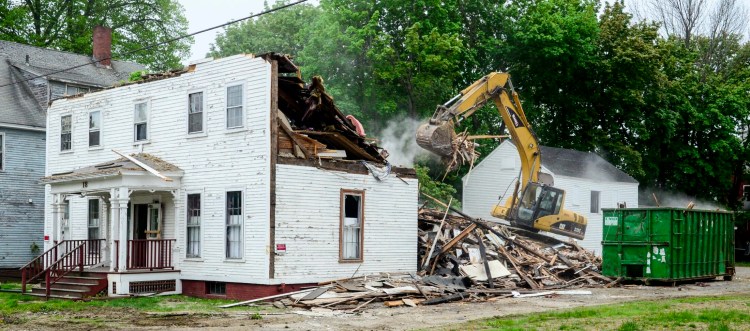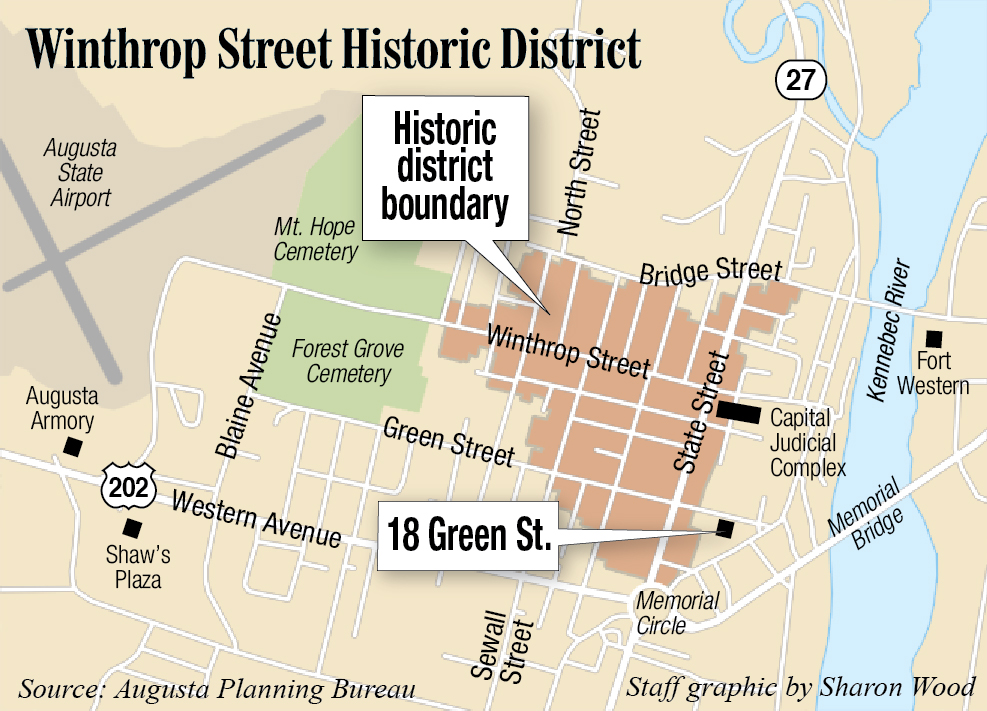AUGUSTA — The home that stood at 18 Green St. for 200-plus years is no more.
The structure was demolished this week, with an excavator seen atop the rubble Wednesday. One city councilor called the demolition “a tragedy” following failed efforts in recent years to preserve the historic building.
Targeted for demolition in 2015, the house was spared while the city reviewed its historic significance, as well as its potential inclusion in a local historic district.
A 90-day delay was instituted Nov. 4, 2015, by Augusta’s Historic Preservation Commission; later in the month, a 180-day moratorium was instituted by city councilors for any buildings located inside the boundaries of a proposed local historic district.
Ultimately, the city adopted a local district that did not include the 18 Green St. property, and the demolition delay expired. A little more than three years later, the property owner — Motivational Services, an agency that provides housing and employment services for people with disabilities — demolished the building.
“For whatever reason, the owner of the building did not act on the demolition until this year, when they submitted a permit back in April,” said Robert Overton, Augusta’s director of code enforcement.
Despite the lengthy gap between the delay’s end and demolition taking place, he noted it didn’t need to be reviewed again.
“It didn’t need to go back to (the commission) because several years had passed,” Overton said. “Once the application was complete, which includes proof they notified relevant utility companies and had done asbestos abatement, we were able to issue the demolition permit, which we did in April.”

A look at 18 Green St when it was known as White Hall Inn, circa 1937-1942. This image was taken as part of a Works Progress Administration project that had photographers take photos of properties in Augusta. Photo courtesy of the Kennebec Historical Society
Motivational Services does not have a plan for the property, said John Zarrilli, Motivational Services executive director.
“Right now we’re planning to keep it as open space for the foreseeable future,” he said.
That a three-story, five-bay house built in 1816 could not be preserved is tragic, said Linda Conti, Ward 1 city councilor and a member of Augusta’s Historic Preservation Commission.
“I think it’s a tragedy and part of Augusta’s long track record of squandering its historic legacy, that’s what I think,” she said. “We need to do more to protect the historic aspects of the west side neighborhood and the downtown.
“That’s why I encourage people to ask code enforcement to enforce property maintenance standards around town — that’s why we enacted them,” she added. “How many more buildings are out there whose owners are going to let them fall into disrepair? I don’t know what the solution is, but I hope there is one because this is very distressing.”
STATE OF DISREPAIR
While the building wasn’t condemned, it was in disrepair. Overton said in conversations he had with Motivational Services representatives in 2015, they indicated there was a “pretty significant mold problem” and that it wouldn’t be financially feasible to renovate the building.

A view of 18 Green St. on Nov. 17, 2015. Kennebec Journal photo by Andy Molloy
That hadn’t changed in the ensuing years.
Overton said he contacted the agency in the fall to let them know they were in violation of the city’s property maintenance ordinance and action was needed.
“Our ordinance requires the exterior to be properly maintained, to not have chipping paint, for there to be no damaged areas,” he said. “Really, every portion of the exterior of the building was in violation of the ordinance.”
Zarrilli confirmed the building’s state of disrepair.
“It was dilapidated, inside and out, and the cost of rehabilitating it would have been prohibitive,” he said.
While he could not provide a specific amount, Zarrilli said it would have cost “several hundred thousand dollars.”
“We looked at the possibility of converting it to apartment units,” he said, adding there is a Portland-based developer the agency works with to undertake such projects, “but the project wasn’t eligible for historic tax credits. With the credits, it would have been feasible to do it.”
PRESERVATION OPTIONS
While buildings older than 50 years can be torn down, the city has a wrecking and demolition delay review process. Once a demolition permit is submitted, the city’s Historic Preservation Commission uses a set of five criteria to determine the building’s historic significance. They include whether the building:

Demolition work continues Wednesday at 18 Green St. in Augusta. Kennebec Journal photo by Joe Phelan
• is in a state or national register of historic places or within boundaries of an area,
• has been determined to be eligible for listing,
• is on a list of historic buildings adopted by the City Council,
• has documented associations with one or more historic persons or events, or with the broad architectural, cultural, political, economic or social history of the city, state or nation; or
• has documented historical or architectural importance in terms of period, style, method of construction, specific use or association with a recognized builder or architect.
“If they met any of the five criteria of review, then a 90-day delay could be imposed,” said Betsy Poulin, Augusta’s deputy city planner. “The Green Street building met two, according to the commission, and the delay was imposed.”
When the permit was submitted for demolition of 18 Green St. in 2015, city councilors were considering adopting a local historic district with boundaries that expanded beyond those of the Winthrop Street National Historic District.
“When we started, we made it as wide as possible and tried to include as much as possible,” said Ward 1 Councilor Linda Conti, who is also a member of the city’s Historic Preservation Commission. “What we did, to get it passed, was make the local district the same as the national district.
“The outside area, in my view, should be included also,” she added. “But the local district boundaries needed to match the national ones to gain local certified status.”
That means 18 Green St. was not part of the local historic district.
“For a building in the historic district, the Historic District Review Board would review any properties (being proposed for demolition),” said Poulin of buildings older than 50 years. “If a building is outside of a historic district, it still goes to the Historic Preservation Commission, which is a different review.”
If a building is located outside of a historic district, only a 90-day delay can be imposed before a demolition permit can be issued.
“The intent is to figure out if there is a way to maybe save the building,” Poulin said. “Maybe move the building, to give it some time to find funds to rehabilitate it. It’s just an opportunity; it adds a little more time before demolition to see if it maybe could be saved.”
Send questions/comments to the editors.





Success. Please wait for the page to reload. If the page does not reload within 5 seconds, please refresh the page.
Enter your email and password to access comments.
Hi, to comment on stories you must . This profile is in addition to your subscription and website login.
Already have a commenting profile? .
Invalid username/password.
Please check your email to confirm and complete your registration.
Only subscribers are eligible to post comments. Please subscribe or login first for digital access. Here’s why.
Use the form below to reset your password. When you've submitted your account email, we will send an email with a reset code.